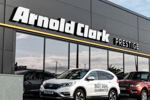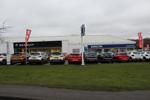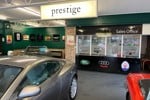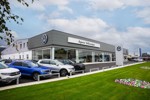Most franchised dealers suffered a sharp reduction in profitability during the first six months of 2000. And, according to analysis for Sewells' Dealer Principal, matters became worse in the second half of the year for four of the six networks studied.
The findings underlined the difficulties faced by motor retailers as buyers held off from making purchases because they were waiting for price cuts.
The six networks involved in the study were two volume manufacturers, two medium-volume and two Japanese, with performance compared between 1999 and 2000.
The highest net profit percentage achieved last year was the 1% recorded by one volume, one medium-volume and one Japanese network.
The other Japanese network in the survey recorded 0.9%. The second volume manufacturer did little better than break-even at 0.2% and the remaining medium-volume carmaker recorded a marginal loss of -0.1%.
Sewells' researchers found dealer profitability was dependent on the achievement of manufacturers' standards-related bonuses.
In 1999, two of the six franchises recorded a loss at the operating profit level. Last year it was four out of six. The level of standards-related bonus (as a percentage of sales) remained substantially the same last year as in 1999 for four of the six networks.
The level of net profitability in them declined in line with their reduced levels of operating profit.
In two of the networks (one volume and one Japanese), the level of standards bonus increased in 2000. This enabled the one volume network to record a marginal increase in net profit (from 0.9% to 1.0%).
In one Japanese network, the increase in average dealer net profit from 0.3% in 1999 to 1.0% in 2000 was entirely due to the substantial increase (up from 0.8% to 1.6% of sales) in standards bonus.
The key financial ratios and departmental contributions for the six networks reflect the many comments made by dealers to the effect that 2000 was a difficult year for the industry.
The pricing issue led to a 'buyers' strike' in the first half of the year, and sales only started to recover in the autumn.
That was when customers began to perceive prices had reduced to a realistic level in comparison with mainland European prices, says Sewells.
The medium-volume network, which had previously performed better than the others, bowed to market pressures in 2000, with its operating profit declining from 1.8% in 1999 to 1.1%.
Support had been given by the manufacturer to dealers through target-related sales bonuses, not standards-related bonus. In 2000, even this approach appears to have been unsuccessful in tempting enough buyers to maintain profitability.
The manufacturer's standards-related bonus remained at by far the lowest level of the six studied at 0.2% – the same level as in 1999.
The balance of rewards in respect of volume, tactical and standards-related bonus varies among carmakers, says Sewells. This meant it was necessary to take the 'below the line' standard bonus contributions into account when comparing the relative profitability of sales departments across the various franchises.
Gross margins in sales departments declined substantially in the volume and medium-volume networks, but increased in both Japanese.
The gross profit margin includes new retail, new fleet, used retail and used trade sales plus manufacturers' tactical bonuses.
Used car margins were maintained at or close to 1999 levels across all franchises and the significant difference was in new car margins.
The two volume franchises both lost around £100 per unit in new retail gross profit margin but maintained gross profit as a percentage of sales at 1999 levels. This is a clear reflection of the reduction in new car prices.
One medium-volume network suffered a large reduction in new car sales margins in both retail and corporate sectors.
New car margins for the second medium-volume network were down only slightly on 1999, and used retail margins were almost exactly the same.
For dealers representing the Japanese companies, used car margins were similar in 1999 and 2000 but they did better with new car margins last year.
New retail gross margins improved last year from 6.4% to 8.0% with one Japanese manufacturer and from 8.0% to 9.3% with the other.
The standards-related bonus remained at around 1.9%, for one Japanese manufacturer in 2000, while doubling to 1.6% for the second.
Sewells says that in response to market conditions and dealer concerns, the Japanese carmakers increased their levels of financial support to dealers in 2000 by a substantial amount in relation to turnover.
Dealers did a commendable job last year in maintaining used car margins, says Sewells, as did some with help from manufacturers in maintaining and even increasing new car margins.
But sales department profitability still fell in four of the six networks surveyed and rose by only 0.1% in one of the other two.
The reason was a substantial increase in sales department expenses as a percentage of sales in most networks, says Sewells. This was because sales were down in the first six to nine months of the year.
Aftersales' absorption (the ability of aftersales departments' profit contribution to cover overheads) declined in all six networks.
The fall from 1998 levels is as high as 20% for some manufacturers and, says Sewells, the sales department contribution has also dropped.
The result is that general overheads as a percentage of sales has increased again and now runs at around 4% of sales in the volume networks, 5% in the medium volume and at 4.5% for the Japanese.
The average level of general overheads as a percentage of sales rose from 4.28% in 1999 to 4.53% in 2000, taking 0.25% off dealership net profit returns.
That percentage appears small but represented 20% of dealer net profit (which averaged 1.22% in 1999) across all six networks, says Sewells.
Dealerships need a rapid and sustained increase in sales to reverse this trend of overheads eating away at the net profit margin, it adds.
Departmental profits from service declined in 2000 in five of the six networks. The average return of 33% in 2000 was down 8% on the 1998 level of 35.7%.
With inflation over the past two years running at around 3%, the profit contribution will have declined in many dealerships as well as the percentage of sales return, says Sewells.
This is seen as a key factor in the reduction in aftersales absorption levels previously noted.
In reports published last year, Sewells recorded some good news in terms of improvements in parts department profitability.
This now seems to have stalled, says Sewells, with four of the six manufacturers recording a fall in their departmental profit.
This is primarily the result of the reduced volume of service work and service-related parts sales.
This might be a knock-on effect from the increased product quality over the past five years, which is good news for car sales, says Sewells – it puts additional pressure on aftersales contributions and therefore on overhead absorption.
Dealers tell Sewells this year has started on a more promising note, with new car buyers back in the showrooms and service business up as well. They hope it lasts and is translated into better returns.
Sewells says dealers cannot survive on a margin of less than 1% on sales, adding: “Manufacturers have to understand that too. Reinvestment in the franchise to improve facilities and service standards – such as paying the good staff more to keep them in the industry – is just not a possibility at the current rate of return.”













Login to comment
Comments
No comments have been made yet.